 |
|
|
1939 - Reports
|
|
From “Cycling” magazine
Vol. XCVII No. 2523 7-Jun-1939
|
|
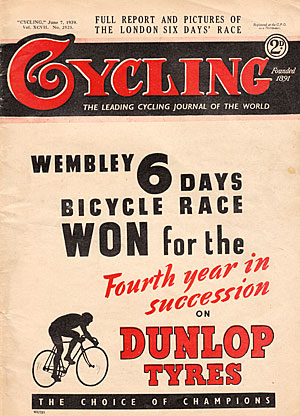 THRILLING FINISH TO LONDON SIX-DAYS RACE THRILLING FINISH TO LONDON SIX-DAYS RACE
Kaers and Debruycker Win By a Lap from Van Vliet and Cor Wals.
Two Englishmen Finish 8th
AMID the wild cheering of 10,000 spectators, a considerable number of whom were in the cyclists' outdoor garb of shorts and alpacas, the famous Belgians, Karel Kaers and Omer Debruycker, late on Saturday won the fourth annual London Six-Days Race held at Wembley Pool by a margin of 170 yds. During the 143 hrs. they covered a total distance of 1,812 1/2 miles.
At 5 p.m. on the last day of the race, world's sprint champion Arie Van Vliet and his partner Cor Wals were level on distance with Kaers and Debruycker of Belgium, and last year's winners, the Belgians A. Buysse and A. Billiet. On points, however, Vliet, tall, studious and bespectacled, and sandy-haired Wals, both from Holland, were leading, and there was every promise of a thrilling evening's battle.
English Boys.
The thousands of eager clubfolk who streamed into the big pillarless hall so soon as the final session began at seven o'clock were not disappointed. And it was S. T. Cozens and B. A. Clare, the Manchester boys, the only Englishmen left in the race, who started the fight at 8.20 p.m. Taking the field by surprise, popular, perky Cozens, still bruised and sore from his spectacular crash a few hours after the race had begun, opened up a gap, and, changing with slim, handsome Clare, the English team soon gained a lap. Ten Minutes later Kaers and Debruycker stole a lap; and the position then was that Vliet and Wals were a lap behind, and three other pairs - 41 year-old Piet Van Kempen and C. Pellnaars, Buysse and Billiet and the Australian favourite Joe Buckley and E. Ignat - were each two laps in arrears. For a few minutes, while the official sprints were started, the field was in a line; but not for long; the tall Dutchmen, Vliet and Wals, were not content to let Kaers and partner hold the lead without a stern struggle. But the Belgians were not to be caught napping.
|
|
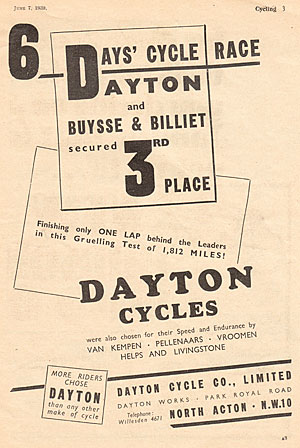 An hour and a half from the end the jam started that was to last until the gun was fired to end the race. Suddenly the blue vest of Buysse left the crowd of riders, and, pedalling furiously, the Belgian opened up a gap. Round and round he sped, high up the banking, down to the inside of the straight, weaving through the relieved riders circling slowly waiting to take over from their sweating partners. But Kaers was not far away. Half an hour to go, and the continual sprinting was beginning to tell upon Van Vliet, who refused any stimulant. His partner Wals, however, appeared to be faster and more determined than ever to get his team back to the lead and at every opportunity he made an effort to get the vital lap that would mean victors. Once it looked as though he would do it. the gap lie opened grew wider and wider; he changed perfectly with Vliet, and then Kaers gave chase in a manner that drew the crowd to its feet to cheer and cheer. Out of the saddle the very picture of fierce aggression, Kaers thundered down the straight, and although Vliet and Wals or their lap, Kaers and partner also ticked up another lap, and so the position was unaltered. No sooner had Kaers brushed the dripping sweat from his eyes than Baysse dashed madly away. Attack followed attack. No quarter was given or received. An hour and a half from the end the jam started that was to last until the gun was fired to end the race. Suddenly the blue vest of Buysse left the crowd of riders, and, pedalling furiously, the Belgian opened up a gap. Round and round he sped, high up the banking, down to the inside of the straight, weaving through the relieved riders circling slowly waiting to take over from their sweating partners. But Kaers was not far away. Half an hour to go, and the continual sprinting was beginning to tell upon Van Vliet, who refused any stimulant. His partner Wals, however, appeared to be faster and more determined than ever to get his team back to the lead and at every opportunity he made an effort to get the vital lap that would mean victors. Once it looked as though he would do it. the gap lie opened grew wider and wider; he changed perfectly with Vliet, and then Kaers gave chase in a manner that drew the crowd to its feet to cheer and cheer. Out of the saddle the very picture of fierce aggression, Kaers thundered down the straight, and although Vliet and Wals or their lap, Kaers and partner also ticked up another lap, and so the position was unaltered. No sooner had Kaers brushed the dripping sweat from his eyes than Baysse dashed madly away. Attack followed attack. No quarter was given or received.
Yet three teams only dominated the race in its closing minutes Kaers and Debruyeker, Van Riot and Wals, and Buysse and Billiet. Of these giants Van Vliet was tiring quickly; and of the rest of the field the English boys Cozens and Clare, still under medical supervision, were game until the end. But nothing could tire Kaers apparently. Not content to sit ever watchful at the head of the procession, in company with the two teams so anxious to defeat him, and await developments, he used his great strength and speed to make matters uncomfortable for those attacking him, and the moment they ended a futile effort to break away he would tear off round the track, determined to give them not a moment's respite.
Then the gun went for the last sprint, and, weary and aching though they must have been, Cozens and Clare tried to out-sprint the masters. But it was no use; away went Buysse and Wals, fighting it out round the banking with others in close attendance; and in that order they crossing the line as the six days race ended.
|
|
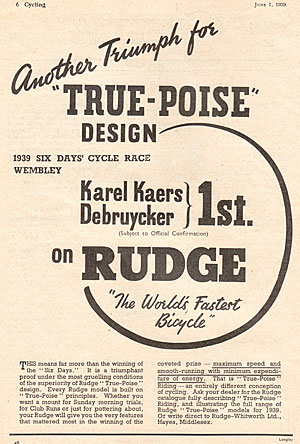 To the strains of the Belgian National Anthem Kaers and Debruycker rode their lap of honour, the big laurels presented to them by Mrs. A. J. Elvin round their shoulders, the blue lights playing upon them as they slowly circled the track. They were the winners; they were indeed the masters of the race. For considerable periods during the week they had held the lead and never was their position seriously challenged by other than Buysse and Billiet, and the world's champion and his partner. At one time, on Friday, Vliet and Wals were five laps behind, but that was mainly the after effects of Vliet's serious crash on Thursday, when he brought down nearly the whole of the field with him. Kaers fell as well on Thursday, but not so seriously. Who was the fastest man in the race - world's champion Van Vliet or ex-world's champion Jeff Scherens, riding his first six-days race? Well, decide for yourself: Vliet won 55 official sprints and Scherens 22; Scherens clocked 11 4/5 secs. for a flying furlong compared with Vliet's 12 1/5 secs., and Vliet was timed to have ridden a 1,000 metres in 1 min. 11 2/5 secs., and Scherens in 1 min. 14 1/5 secs.! To the strains of the Belgian National Anthem Kaers and Debruycker rode their lap of honour, the big laurels presented to them by Mrs. A. J. Elvin round their shoulders, the blue lights playing upon them as they slowly circled the track. They were the winners; they were indeed the masters of the race. For considerable periods during the week they had held the lead and never was their position seriously challenged by other than Buysse and Billiet, and the world's champion and his partner. At one time, on Friday, Vliet and Wals were five laps behind, but that was mainly the after effects of Vliet's serious crash on Thursday, when he brought down nearly the whole of the field with him. Kaers fell as well on Thursday, but not so seriously. Who was the fastest man in the race - world's champion Van Vliet or ex-world's champion Jeff Scherens, riding his first six-days race? Well, decide for yourself: Vliet won 55 official sprints and Scherens 22; Scherens clocked 11 4/5 secs. for a flying furlong compared with Vliet's 12 1/5 secs., and Vliet was timed to have ridden a 1,000 metres in 1 min. 11 2/5 secs., and Scherens in 1 min. 14 1/5 secs.!
The story of Charlie Helps's participation in the race can quickly be told. He was concerned in several crashes in the early stages, and, although he continued to ride pluckily and with increasing confidence, the ex-British amateur champion who turned professional specially for this race was withdrawn from the race in the early hours of Tuesday morning when the Irishman Bill Livingstone was forced to retire. Helps was taken out in order that Livingstone's partner Montero, from Spain, could pair up with Helps's partner Vroomen, from Holland.
The full story of the race is told in detail in the following pages. Look down the mileage figures and you will note that in the 70th hour the riders covered 31.8 miles per hour. In the first hour they covered 26.6 m.p.h. and it the last 29.3 m.p.h. Altogether it is the story of yet another successful promotion by the organizer, white-haired ex-racing cyclist Arthur Shepherd. When are we going to have a permanent indoor racing track?
|
|
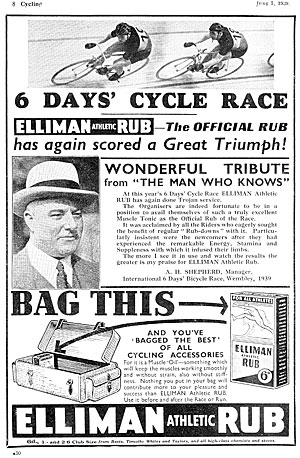 Detailed Reports (being proof read ...) Detailed Reports (being proof read ...)
Monday The latest positions to hand, when Cycling went to press last week showed the Australian Joe Buckley and his French partner Emile Ignat to be in the lead, one lap ahead of Van Vliet and Cox Wals, Dekuysschere and Scherens and Buysse and Billiet, last year's winners. Of the four leading teams, Vliet and Wals were ahead on points, having scored 115 points. Shortly after 9.30 on Monday evening, however, the two Alberts, Buysse and Billiet, set out to make up some of their arrears, and a 10-minute jam was the result. When the pace eased up Buysse and Billiet were one lap up on the field. The 10 o'clock sprints gave Vliet and Wals some more valuable sprint points, and with the last sprint over another jam was started and lasted for three hours, right into early on Tuesday morning. After some hectic riding Buysse and Billiet had added another lap to their lead, while Karel Kaers and Debruycker moved into second position, equal in distance but ahead on points to Buckley and Ignat. Fourth were Van Vliet and Wals, four laps behind the leaders but over 100 points ahead of any other team in the race. During the jamming the Irishman Bill Livingstone, who had not shown much confidence on the fast track, had a couple of spills and had to receive medical attention. The crowd gave a terrific welcome back to Syd Cozens, whose spectacular crash on Monday morning was reported in Cycling last week.
Tuesday Early this morning Livingstone was forced to retire with a damaged hand, and Charlie Helps, the newly turned British professional, was withdrawn from the race to allow his partner Vroomen to team up with Livingstone's partner Montero, the Spaniard. This new combination started off with a deficit of 20 laps, but Vroomen quickly gained a lap during the afternoon, when Van Vliet and Wals were again well to the fore during the sprints and further increased their points lead.
The evening was brighter than the afternoon racing, however, and a £5 prime for the first team to gain a lap at 9.0 started a furious jam that lasted an hour. Benny Clare tumbled during this jam, but apart from a burnt leg and a shaking he was not damaged, although off the track for about half an hour. When the pressure eased, Buysse and Billiet were still leading, but by one lap only, from Kaers and Debruycker, with Buckley and Ignat third two laps behind, and Wals and Vliet fourth a further lap behind. 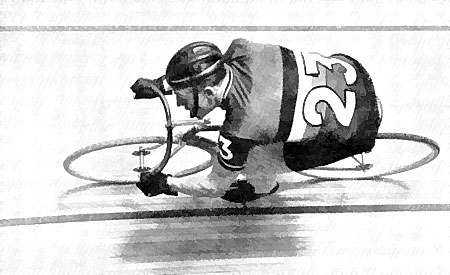 During the later stages of this jam the riders who shone most were Scherens and Vliet, the two sprinters, who both showed that their ability to go fast was not confined to the last furlong. Sling changes were also well in evidence. The evening session was interposed by an attempt on the "Flying Furlong " by Syd Cozens, who recorded 12 4/5 secs., 3/5 sec. slower than Van Vliet's effort on Monday afternoon and the second fastest of the evening. Fastest furlong of the evening was 12 3/5 secs. by Joe Buckley, so it was clear that Cozens had got over the worst effects of his crash. Another intermission that caused some considerable interest was the 2-mile sling change pursuit race between Buckley and Ignat and Letourneur and Guimbretiere. After a good fight the two Frenchmen were the winners by 4 4/5 secs. During the later stages of this jam the riders who shone most were Scherens and Vliet, the two sprinters, who both showed that their ability to go fast was not confined to the last furlong. Sling changes were also well in evidence. The evening session was interposed by an attempt on the "Flying Furlong " by Syd Cozens, who recorded 12 4/5 secs., 3/5 sec. slower than Van Vliet's effort on Monday afternoon and the second fastest of the evening. Fastest furlong of the evening was 12 3/5 secs. by Joe Buckley, so it was clear that Cozens had got over the worst effects of his crash. Another intermission that caused some considerable interest was the 2-mile sling change pursuit race between Buckley and Ignat and Letourneur and Guimbretiere. After a good fight the two Frenchmen were the winners by 4 4/5 secs.
Wednesday At the start of the afternoon session matters were very subdued and the only time the riders increased their speed was for the official sprints. Just before the final sprint of the afternoon, however, Vroomen, the cheery Dutchman, took the field by surprise and with his partner Montero gained a very quick lap. After the last sprint Vroomen went away again. but this time the field was prepared and, with Buysse in the lead, the fugitive was caught. But the jam did not die down, for several other teams made attempts to break- away, but all without success. The jam came to a sudden end when Wals took the bend rather wide and sent Moiltero and Letourneur up the banking. These two riders were travelling fast and as their bodies touched Letourneur was shot into the safety wires at the top of the track, where he hung, bleeding and half unconscious, while Montero rolled down the banking, taking several other riders with him, including Benny Clare, who fell rather heavily on his shoulder. When the tangle of machines and men was sorted out Montero lay at the foot of the track unconscious, while an attendant climbed along the top of the track to rescue Letourneur, who was the most seriously hurt. Montero soon recovered and was riding again, but Letourneur was taken away to receive medical aid and, with his partner Guimbretiere, was neutralized. The crash occurred in precisely the same spot where Syd Cozens, the English rider, was injured on opening night. The evening provided the most interesting racing to date. Early on five riders made attempts on the "Flying Furlong," four of them, Van Kempen, Pellenaars, Stieler and Vroomen, recording the same time of 12 4/5 secs. Miss Marguerite Wilson, the Hercules girl professional, looking very charming in shorts and blouse, rode a lap of honour and seemed to meet with the approval of the riders, who very nearly forgot to keep moving. Shortly after nine o'clock a £5 prime was offered for the first lap gained. Within a few laps Van Vliet and Wals had won the prime, and then the fun started. With a large crowd voicing Its very evident approval, the riders plunged into a fierce jam, and laps were gained with amazing rapidity.
|
SCHERENS—MUSIC MAESTRO!
WE have all heard of Jeff Scherens, six times world sprint champion, as a super cyclist, and on a few occasions as an airman, but during the week a record of one of Scherens's musical com- positions for the accordion was played. When in his home country Scherens is also the leader of an orchestra!
|
|
The lead changed hands several times, and at 9.20 p.m. Kaers and Debruycker were one lap ahead of the field. They were later caught by Vliet and Wals, who then led the race on points. After a few more minutes, however, the indomitable Belgians Buysse and Billiet were away and gained a lap on the field to take the lead. But the struggle between the three teams of Buysse-Billiet, Vliet-Wals, and Kaers-Debruycker continued and within three minutes the lead interchanged between three teams. When the jam finished at 9.45, Kaers and Debruycker had a lap lead from Vliet and Wals, and Buysse and Billiet, with Buckley and Ignat fourth, a further lap behind. A noticeable feature throughout all this fierce jamming, was the fine form shown by Joe Buckley, who can now be reckoned with the leaders in the six-day game. After a break, while Kaers and Debruycker and Van Kempen and Pellenaars had a sling pursuit race, another jam was started by Van Vhet at 10.45, and away went the whole mad medley of flying figures once more. During this jam Benny Clare's back tyre rolled off and he crashed heavily, and his shoulder, that had borne the brunt, of several of his falls, again took the shock, and Benny had to leave the track for attention. He did not return for the rest of the evening. Shortly after, Buysse punctured while travelling at speed and skidded for some way on a portion of his anatomy specially padded for that contingency. He was unhurt, however, except in his dignity.

More to follow |
|
Do you have any copies of more items that you can share?
|
|
|
|
|
|